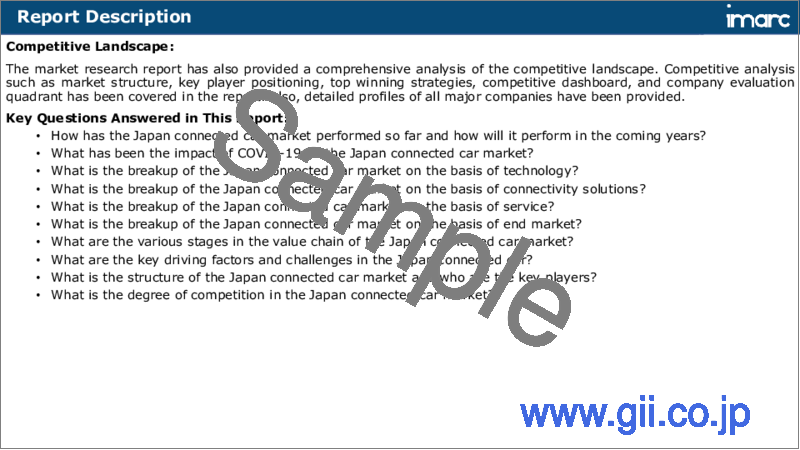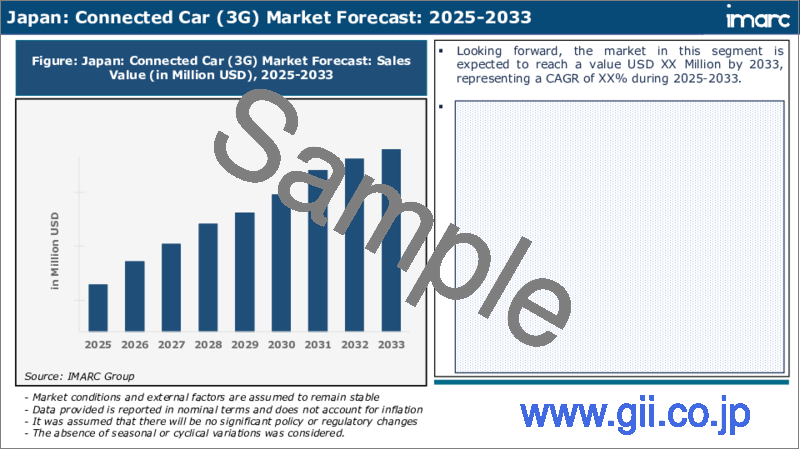|
|
市場調査レポート
商品コード
1609793
日本のコネクテッドカー市場レポート:技術、コネクティビティソリューション、サービス、エンドマーケット、地域別、2025年~2033年Japan Connected Car Market Report by Technology, Connectivity Solutions, Service, End Market (Original Equipment Manufacturer, Aftermarket), and Region 2025-2033 |
||||||
カスタマイズ可能
|
|||||||
| 日本のコネクテッドカー市場レポート:技術、コネクティビティソリューション、サービス、エンドマーケット、地域別、2025年~2033年 |
|
出版日: 2024年12月05日
発行: IMARC
ページ情報: 英文 121 Pages
納期: 5~7営業日
|
- 全表示
- 概要
- 目次
日本のコネクテッドカー市場規模は2024年に61億米ドルに達しました。今後、IMARC Groupは、2025年から2033年にかけて20.4%の成長率(CAGR)を示し、2033年までに321億米ドルに達すると予測しています。ナビゲーションサービスにアクセスするための中断のない接続性への依存の高まりが、市場成長の推進力となっています。
本レポートで扱う主な質問
- 日本のコネクテッドカー市場はこれまでどのように推移し、今後どのように推移するのか?
- COVID-19が日本のコネクテッドカー市場に与えた影響は?
- 日本のコネクテッドカー市場の技術別内訳は?
- 日本のコネクテッドカー市場のコネクティビティソリューション別内訳は?
- 日本のコネクテッドカー市場のサービス別内訳は?
- 日本のコネクテッドカー市場のエンドマーケット別の内訳は?
- 日本のコネクテッドカー市場のバリューチェーンにおける様々な段階とは?
- 日本のコネクテッドカーの主な促進要因と課題は?
- 日本のコネクテッドカー市場の構造と主要プレーヤーは?
- 日本のコネクテッドカー市場における競合の程度は?
目次
第1章 序文
第2章 調査範囲と調査手法
- 調査の目的
- ステークホルダー
- データソース
- 市場推定
- 調査手法
第3章 エグゼクティブサマリー
第4章 日本のコネクテッドカー市場:イントロダクション
- 概要
- 市場力学
- 業界動向
- 競合情報
第5章 日本のコネクテッドカー市場情勢
- 過去および現在の市場動向(2019年~2024年)
- 市場予測(2025-2033)
第6章 日本のコネクテッドカー市場:技術別内訳
- 3G
- 4G/LTE
- 5G
第7章 日本のコネクテッドカー市場:コネクティビティソリューション別内訳
- 統合型
- 埋め込み
- テザリング型
第8章 日本のコネクテッドカー市場:サービス別内訳
- ドライバーアシスタンス
- 安全性
- エンターテインメント
- 車両管理
- モビリティ管理
- その他
第9章 日本のコネクテッドカー市場:エンドマーケット別内訳
- オリジナル機器製造会社(OEM)
- アフターマーケット
第10章 日本のコネクテッドカー市場:競合情勢
- 概要
- 市場構造
- 市場プレーヤーのポジショニング
- 主要成功戦略
- 競合ダッシュボード
- 企業評価象限
第11章 主要企業のプロファイル
第12章 日本のコネクテッドカー市場:業界分析
- 促進要因・抑制要因・機会
- ポーターのファイブフォース分析
- バリューチェーン分析
第13章 付録
Japan connected car market size reached USD 6.1 Billion in 2024. Looking forward, IMARC Group expects the market to reach USD 32.1 Billion by 2033, exhibiting a growth rate (CAGR) of 20.4% during 2025-2033. The growing dependency on uninterrupted connectivity to access navigation services is providing a thrust to the market growth.
Connected cars are automobiles integrated with internet connectivity and advanced communication technologies, enabling the seamless exchange of information through multiple communication channels. Their purpose is to enhance vehicle performance, provide added convenience to users, and enable effective communication between the transportation system and its environment to prevent road accidents and offer notifications about available parking spaces. These vehicles also deliver immediate traffic alerts to drivers and can trigger emergency services in case of unforeseen incidents. Additionally, these alerts and signals contribute to the improvement of overall traffic performance and management of road safety, all while ensuring optimal driving comfort.
Japan Connected Car Market Trends:
The Japan connected car market is primarily stimulated by the growing need for in-car safety solutions. Consequently, the extensive integration of connected cars with advanced driver-assistance systems (ADAS) for obstacle mapping and anti-lock braking systems (ABS) to facilitate secure braking is poised to foster a favorable market outlook. Additionally, the introduction of 5G connectivity and the increasing adoption of artificial intelligence (AI) and machine-to-machine (M2M) connectivity among multiple vehicles are positively influencing the market. Simultaneously, continuous advancements in the production of sophisticated suspension systems are providing further momentum to the market. The market's momentum is additionally bolstered by the increasing preference for luxury cars among individuals with substantial disposable incomes and the emergence of trends related to autonomous driving. Other contributing factors to market growth include the rapid digitalization across the automotive sector and extensive research and development (R&D) initiatives undertaken by key industry players. In addition, the enforcement of strict regulations by governments in various nations has compelled automotive producers to create vehicles equipped with ADAS attributes in response to mounting apprehensions about passenger safety, thereby aiding market expansion. Furthermore, factors such as continuous research and development (R&D) endeavors, swift digitalization in the automotive industry, and the emergence of self-driving trends are also expected to foster a favorable market perspective.
Japan Connected Car Market Segmentation:
Technology Insights:
- 3G
- 4G/LTE
- 5G
Connectivity Solutions Insights:
- Integrated
- Embedded
- Tethered
Service Insights:
- Driver Assistance
- Safety
- Entertainment
- Vehicle Management
- Mobility Management
- Others
End Market Insights:
- Original Equipment Manufacturer (OEMs)
- Aftermarket
Competitive Landscape:
The market research report has also provided a comprehensive analysis of the competitive landscape. Competitive analysis such as market structure, key player positioning, top winning strategies, competitive dashboard, and company evaluation quadrant has been covered in the report. Also, detailed profiles of all major companies have been provided.
Key Questions Answered in This Report:
- How has the Japan connected car market performed so far and how will it perform in the coming years?
- What has been the impact of COVID-19 on the Japan connected car market?
- What is the breakup of the Japan connected car market on the basis of technology?
- What is the breakup of the Japan connected car market on the basis of connectivity solutions?
- What is the breakup of the Japan connected car market on the basis of service?
- What is the breakup of the Japan connected car market on the basis of end market?
- What are the various stages in the value chain of the Japan connected car market?
- What are the key driving factors and challenges in the Japan connected car?
- What is the structure of the Japan connected car market and who are the key players?
- What is the degree of competition in the Japan connected car market?
Table of Contents
1 Preface
2 Scope and Methodology
- 2.1 Objectives of the Study
- 2.2 Stakeholders
- 2.3 Data Sources
- 2.3.1 Primary Sources
- 2.3.2 Secondary Sources
- 2.4 Market Estimation
- 2.4.1 Bottom-Up Approach
- 2.4.2 Top-Down Approach
- 2.5 Forecasting Methodology
3 Executive Summary
4 Japan Connected Car Market - Introduction
- 4.1 Overview
- 4.2 Market Dynamics
- 4.3 Industry Trends
- 4.4 Competitive Intelligence
5 Japan Connected Car Market Landscape
- 5.1 Historical and Current Market Trends (2019-2024)
- 5.2 Market Forecast (2025-2033)
6 Japan Connected Car Market - Breakup by Technology
- 6.1 3G
- 6.1.1 Overview
- 6.1.2 Historical and Current Market Trends (2019-2024)
- 6.1.3 Market Forecast (2025-2033)
- 6.2 4G/LTE
- 6.2.1 Overview
- 6.2.2 Historical and Current Market Trends (2019-2024)
- 6.2.3 Market Forecast (2025-2033)
- 6.3 5G
- 6.3.1 Overview
- 6.3.2 Historical and Current Market Trends (2019-2024)
- 6.3.3 Market Forecast (2025-2033)
7 Japan Connected Car Market - Breakup by Connectivity Solutions
- 7.1 Integrated
- 7.1.1 Overview
- 7.1.2 Historical and Current Market Trends (2019-2024)
- 7.1.3 Market Forecast (2025-2033)
- 7.2 Embedded
- 7.2.1 Overview
- 7.2.2 Historical and Current Market Trends (2019-2024)
- 7.2.3 Market Forecast (2025-2033)
- 7.3 Tethered
- 7.3.1 Overview
- 7.3.2 Historical and Current Market Trends (2019-2024)
- 7.3.3 Market Forecast (2025-2033)
8 Japan Connected Car Market - Breakup by Service
- 8.1 Driver Assistance
- 8.1.1 Overview
- 8.1.2 Historical and Current Market Trends (2019-2024)
- 8.1.3 Market Forecast (2025-2033)
- 8.2 Safety
- 8.2.1 Overview
- 8.2.2 Historical and Current Market Trends (2019-2024)
- 8.2.3 Market Forecast (2025-2033)
- 8.3 Entertainment
- 8.3.1 Overview
- 8.3.2 Historical and Current Market Trends (2019-2024)
- 8.3.3 Market Forecast (2025-2033)
- 8.4 Vehicle Management
- 8.4.1 Overview
- 8.4.2 Historical and Current Market Trends (2019-2024)
- 8.4.3 Market Forecast (2025-2033)
- 8.5 Mobility Management
- 8.5.1 Overview
- 8.5.2 Historical and Current Market Trends (2019-2024)
- 8.5.3 Market Forecast (2025-2033)
- 8.6 Others
- 8.6.1 Historical and Current Market Trends (2019-2024)
- 8.6.2 Market Forecast (2025-2033)
9 Japan Connected Car Market - Breakup by End Market
- 9.1 Original Equipment Manufacturer (OEMs)
- 9.1.1 Overview
- 9.1.2 Historical and Current Market Trends (2019-2024)
- 9.1.3 Market Forecast (2025-2033)
- 9.2 Aftermarket
- 9.2.1 Overview
- 9.2.2 Historical and Current Market Trends (2019-2024)
- 9.2.3 Market Forecast (2025-2033)
10 Japan Connected Car Market - Competitive Landscape
- 10.1 Overview
- 10.2 Market Structure
- 10.3 Market Player Positioning
- 10.4 Top Winning Strategies
- 10.5 Competitive Dashboard
- 10.6 Company Evaluation Quadrant
11 Profiles of Key Players
- 11.1 Company A
- 11.1.1 Business Overview
- 11.1.2 Product Portfolio
- 11.1.3 Business Strategies
- 11.1.4 SWOT Analysis
- 11.1.5 Major News and Events
- 11.2 Company B
- 11.2.1 Business Overview
- 11.2.2 Product Portfolio
- 11.2.3 Business Strategies
- 11.2.4 SWOT Analysis
- 11.2.5 Major News and Events
- 11.3 Company C
- 11.3.1 Business Overview
- 11.3.2 Product Portfolio
- 11.3.3 Business Strategies
- 11.3.4 SWOT Analysis
- 11.3.5 Major News and Events
- 11.4 Company D
- 11.4.1 Business Overview
- 11.4.2 Product Portfolio
- 11.4.3 Business Strategies
- 11.4.4 SWOT Analysis
- 11.4.5 Major News and Events
- 11.5 Company E
- 11.5.1 Business Overview
- 11.5.2 Product Portfolio
- 11.5.3 Business Strategies
- 11.5.4 SWOT Analysis
- 11.5.5 Major News and Events
12 Japan Connected Car Market - Industry Analysis
- 12.1 Drivers, Restraints, and Opportunities
- 12.1.1 Overview
- 12.1.2 Drivers
- 12.1.3 Restraints
- 12.1.4 Opportunities
- 12.2 Porters Five Forces Analysis
- 12.2.1 Overview
- 12.2.2 Bargaining Power of Buyers
- 12.2.3 Bargaining Power of Suppliers
- 12.2.4 Degree of Competition
- 12.2.5 Threat of New Entrants
- 12.2.6 Threat of Substitutes
- 12.3 Value Chain Analysis





